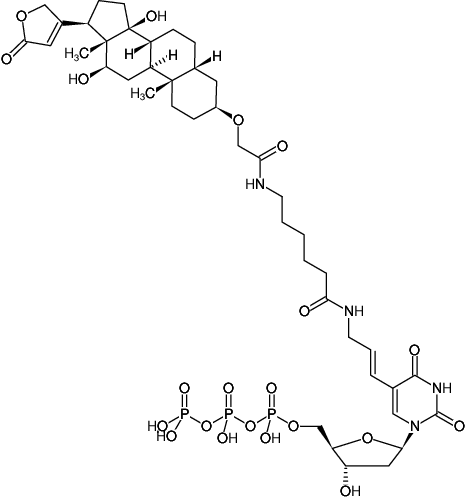Digoxigenin-X-(5-aminoallyl)-2'-deoxyuridine-5'-triphosphate, Triethylammonium salt
alkali-stable
| Cat. No. | Amount | Price (EUR) | Buy / Note |
|---|---|---|---|
| NU-803-DIGX-S | 25 μl (1 mM) | 162,30 | Add to Basket/Quote Add to Notepad |
| NU-803-DIGX-L | 5 x 25 μl (1 mM) | 475,30 | Add to Basket/Quote Add to Notepad |

For general laboratory use.
Shipping: shipped on gel packs
Storage Conditions: store at -20 °C
Short term exposure (up to 1 week cumulative) to ambient temperature possible.
Shelf Life: 12 months after date of delivery
Molecular Formula: C43H65N4O21P3 (free acid)
Molecular Weight: 1066.91 g/mol (free acid)
Exact Mass: 1066.34 g/mol (free acid)
Purity: ≥ 95 % (HPLC)
Form: filtered solution (30 kDa) in 10 mM Tris-HCl
Color: colorless to slightly yellow
Concentration: 1.0 mM - 1.1 mM
pH: 7.5 ±0.5
Spectroscopic Properties: λmax 290 nm, ε 8.8 L mmol-1 cm-1 (Tris-HCl pH 7.5)
Applications:
Incorporation into DNA/cDNA by
- PCR with Taq polymerase [1,2] & in-house data
- Nick Translation with DNAse I/ DNA Polymerase I [3] and in-house data
- Primer Extension with Klenow exo- [4]
- 3’-End Labeling with Terminal deoxynucleotidyl Transferase (TdT) [5]
- Reverse Transcription with MMLV Reverse Transcriptase [6]
Incorporation into RNA by
- 3’-End Labeling with Terminal deoxynucleotidyl Transferase (TdT) [7]
Description:
Digoxigenin-11-dUTP is enzymatically incorporated into DNA/cDNA as substitute for its natural counterpart dTTP. The resulting Digoxigenin-labeled DNA/cDNA probes are subsequently detected using Digoxigenin-antibodies conjugated with horseradish peroxidase (HRP), alkaline phosphatase (AP) or a fluorescent dye. Optimal substrate properties and thus labeling efficiency is ensured by a 11-atom linker attached to the C5 position of uridine.
Recommended Digoxigenin-11-dUTP/dTTP ratio for PCR and Nick Translation: 35% Digoxigenin-11-dUTP/ 65% dTTP
Please note: The optimal final concentration of Digoxigenin-11-dUTP may very depending on the application and assay conditions. For optimal product yields and high incorporation rates an individual optimization of the Digoxigenin-11-dUTP/dTTP ratio is recommended.
Related products:
BIOZ Product Citations:
Selected References:
[1] Anderson et al. (2005) Incorporation of reporter-labeled nucleotides by DNA polymerases. Biotechniques 38:257.
[2] Jackson et. al (1991) Detection of Shiga Toxin-Producing Shigella dysenteriae Type 1 and Escherichia coli by Using Polymerase Chain Reaction with Incorporation of Digoxigenin-11-dUTP. J Clin Microbiol. 29 (9):1910.
[3] Dauwerse et al. (1999) Two-colour FISH detection of the inv (16) in interphase nuclei of patients with acute myeloid leukemia. Br J Haematol 106:111.
[4] Wiegant et al. (2008) Probe Labeling and Fluorescence In Situ Hybridization. Current Protocols in Cytometry: Unit 8.3.
[5] Schmitz et al. (2008) Nonradioactive labeling of oligonucleotides in vitro with the hapten digoxigenin by tailing with terminal transferase. Anal Biochem 199:222.
[6] Grimmond et al. (2001) Expression Profiling with cDNA Microarray's: A User's Perspective and Guide. In: DNA Microarrays: Gene Expression Applications (Jordan). Springer Verlag Berlin Heidelberg.
[7] Rosemeyer et al. (1995) Nonradioactive 3'-end-labeling of RNA molecules of different lengths by terminal deoxynucleotidyltransferase Anal Biochem 224:446.